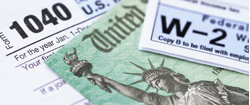Now that the 2023 tax season is over, we’re looking ahead to next year. There are steps you can take now to make sure your tax filing experience goes smoothly in 2024. By organizing your financial documents and keeping track of deductible expenses, you can save yourself time and stress next year. It’s also a good idea to review any tax law changes that might impact your return to ensure there are no surprises. Taking these small steps can help you prepare for taxes before yearend and set you up for a hassle-free filing experience.
Check Your Withholding and Make Any Adjustments
Your tax withholding determines how much is taken out of your paychecks for taxes each month. How much you should withhold will depend on your filing status and annual income. It’s especially important to check your withholding if you:
• Received a smaller refund than expected after filing your 2022 taxes this year.
• Owed an unexpected tax bill in 2023.
• Experienced personal or financial changes that might change your tax liability.
You may owe an unexpected tax bill when they file their 2023 tax return next year, if you didn’t have enough withheld throughout the year. To avoid this kind of surprise, taxpayers should use the Tax Withholding Estimator to perform a quick paycheck or pension income checkup. Doing so can help you decide if you need to adjust your withholding or make estimated or additional tax payments now. This tool provides an easy way to ensure you are meeting your tax obligations and avoiding potential penalties for underpayment. Having the filing taxes requirements explained through helpful resources like this can make the process more manageable and reduce the stress of tax season. Taking these proactive steps now can set you up for a smoother experience when it’s time to file your 2023 tax return.
Organize Your Tax Documents
The off-season is a great time to organize your tax files so you’re ready for next year. Keep a clear recordkeeping system. Whether it’s electronic or paper, use a system to keep all important information in one place. Having all needed documents and IRS forms on hand before you prepare your return will help you file a complete and accurate tax return.
This includes:
• Your 2022 tax return.
• Form W-2 from employers.
• Form 1099 from banks and other payers.
• Forms 1095-A from the marketplace for those claiming the premium tax credit.
• Form 1099-NEC, Nonemployee Compensation
• Notice 1444, Your Economic Impact Payment.
Most income is taxable, including unemployment compensation, refund interest, and income from the gig economy and virtual currencies. Therefore, taxpayers should also gather any documents from these types of earnings. Keep copies of your tax returns and all supporting documents for at least three years.
Confirm Mailing and Email Addresses
To make sure you receive your IRS forms on time, confirm now that each employer, bank, and other payer have your current mailing address or email address. Typically, forms start arriving by mail or are available online in January.
Check Your Individual Tax Identification Number (ITIN)
An ITIN is a tax processing number issued by the Internal Revenue Service for those who do not have (and are not eligible for) a social security number. If you have an ITIN, double-check it’s expiration date. If it is expired, you will need to renew it.
Note: ITINs with middle digits 70, 71, 72, 73, 74, 75, 76, 77, 78, 79, 80, 81, 82, 83, 84, 85, 86, 87, or 88 have expired. In addition, ITINs with middle digits 90, 91, 92, 94, 95, 96, 97, 98, or 99, if assigned before 2013, have expired.
If you don’t renew your ITIN, the IRS can still process your tax return, but it may take longer to process and/or issue any credits or refunds owed.
Set Up Direct Deposit for Faster Returns
The fastest way to get your return is to e-file and set up direct deposit. You can have the IRS deposit your refund to up to three different bank accounts. Simply select direct deposit on your e-filing solution (ezTaxReturn makes it easy!) and enter your account and routing numbers.
Direct deposit is fast and secure—which is why 8 out of 10 taxpayers use it.
It’s never too soon to start prepping for the next tax year. Set yourself up for success in 2024 with these tips. And when you’re ready, start your free tax filing with ezTaxReturn.
File your taxes fast, ez and hassle-free.
The articles and content published on this blog are provided for informational purposes only. The information presented is not intended to be, and should not be taken as, legal, financial, or professional advice. Readers are advised to seek appropriate professional guidance and conduct their own due diligence before making any decisions based on the information provided.




